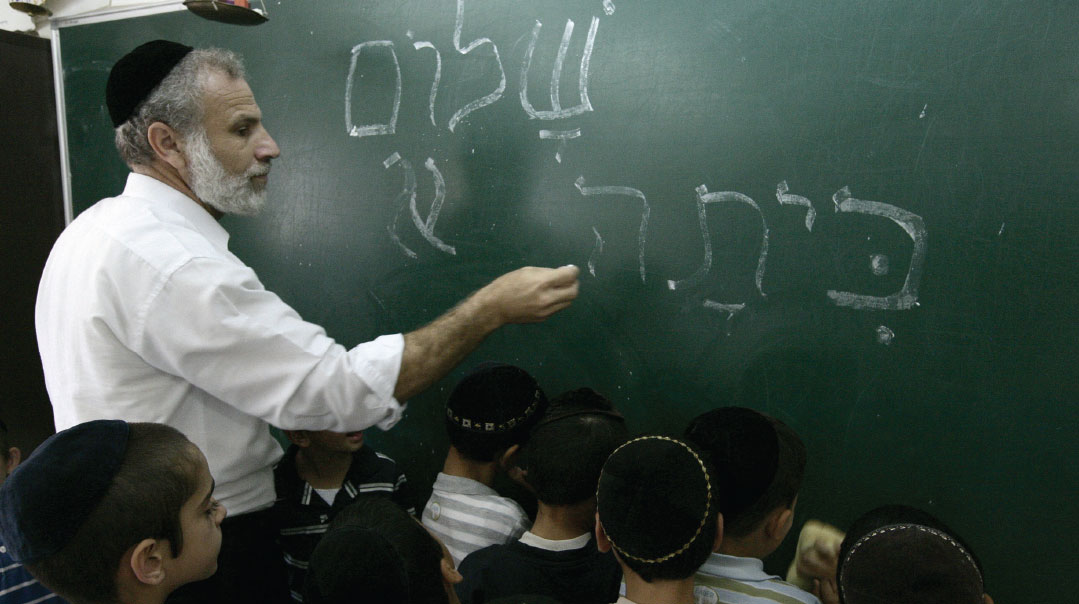It’s Our Problem

Anti-Semitism is very much a Jewish problem, and we play a very pronounced role in its elimination

"French Jews have largely abandoned public schools. Some 70 percent of all school-age Jews, among the highest proportion in Europe, now attend religious schools. Sports programs are also increasingly Jewish-only matches, as are cultural events.”
So writes journalist Judith Miller in a piece in City Journal on the precarious situation of French Jews amid the upsurge in anti-Semitism there. Although she rues about the ill effects of anti-Semitism in France as a new, sad reality, the cultural and educational separation she cites as anti-Semitism has actually been a cause for celebration from earliest times.
In Ms. Miller’s description, too, there springs to life what countless gedolei Yisrael have written to decipher the enigma of Jew-hatred. The great Volozhiner roshei yeshivah, the Beis HaLevi and the Netziv, each wrote in detail about the beginnings of our enslavement in Mitzrayim as an early, paradigmatic episode of Jew-hatred (albeit not the first, as the Haggadah’s reference to Lavan’s attempt to obliterate us makes clear).
In the midst of recounting the Divine kindnesses to the Jewish People in Egypt, Dovid Hamelech says (Tehillim 105:25) “Hafach libam lisno amo — He turned the Egyptians’ hearts to hate His nation.” So it was Hashem Who stood behind the hatred of the Jews. But why would He do that, and what sort of kindness is that?
The Beis HaLevi explains that following Yosef’s death, the Jews understood that the beginning of centuries-long enslavement foretold to Avraham at the Bris bein Habesarim was drawing near. They frantically sought some way to ameliorate what awaited them, and decided to do away with bris milah, the better to begin blending into Egyptian society. The result was a Divinely instigated backlash of wrath and revulsion on the part of the Egyptians, which served to keep the now-reviled Jews at bay — and to keep them Jewish as well.
Similarly, writes the Netziv, Yosef saw to it that the Jews lived separately in Eretz Goshen as his father Yaakov had instructed, but with Yosef’s passing, they spread out until “the land was full of them,” dwelling cheek by jowl with the Egyptians and becoming ever more like them. As the process of exchanging their Jewish identities for Egyptian ones accelerated, Hashem brought a halt to it by unleashing the enmity of Egypt down upon them. And that, writes the Netziv, is precisely why it is that “in every generation they rise up to destroy us.”
Elsewhere, he explains in this spirit the meaning of Bilaam’s prophetic description of the Jewish People as “a nation that dwells alone, and is not reckoned among the nations.” The normal dynamic in which integration into a society brings acceptance and success works precisely backward for the Jews. So long as Klal Yisrael keeps its distance from the gentiles, it can be assured of dwelling in peace and having their respect. Once it seeks acculturation and assimilation in an attempt to join the family of nations, however, it will be treated as even less than human.
In a recent essay in First Things on the contemporary flaring of anti-Semitism, Orthodox author and academic Erica Brown writes that although “some trace the origins of anti-Semitism to the New Testament era, it is hard to ignore the implicit anti-Semitism in the Esther story….” But, of course, it is far more ancient than even the gezeirah of Haman.
She writes that Haman’s speech to Achashveirosh about the Jews reminds her of how
Theodor Herzl could not understand why, despite their noteworthy contributions to society, Jews were continually branded outsiders: “In vain we are loyal patriots, in some places our loyalty running to extremes; in vain do we make the same sacrifices of life and property as our fellow citizens; in vain do we strive to increase the fame of our native land in science and art, or her wealth by trade and commerce. In countries where we have lived for centuries we are still cried down as strangers.... If we could only be left in peace....”
“Yad Vashem,” Brown continues, “is next to Har Herzl, a sprawling military cemetery named after the same man who believed that a future without anti-Semitism was only possible if Jewish influence was twinned with Jewish autonomy. Maybe, Herzl thought, the best way to fight hate is not to fight it at all, but to move away from it before it catches you in its grip.” How did that theory work out?
She concludes that “anti-Semitism is a persistent Jewish concern but is not really a Jewish problem. It’s the disease of those who greet difference with violence. It can never, therefore, be eliminated by Jews. It must be eradicated by non-Jews willing to fight all forms of hatred.”
Ms. Brown makes the mistake of adopting the contemporary trope that universalizes Jew-hatred as some sort of generic dislike of the unlike, requiring a fight against “all forms of hatred.” It’s the sort of lazy, hazy rhetoric one encounters in Holocaust museums worldwide.
More importantly, however, her understanding of the very nature of this most supernatural of phenomena is tragically mistaken. Chazal, and the gedolei hadoros who have interpreted their messages to us, teach that anti-Semitism is very much a Jewish problem, and that Jews play a very pronounced role in its elimination — far greater than that of non-Jews, who are but pawns in the game.
Originally featured in Mishpacha, Issue 800. Eytan Kobre may be contacted directly at kobre@mishpacha.com
Oops! We could not locate your form.






